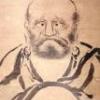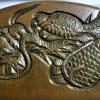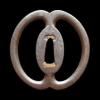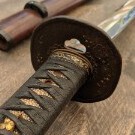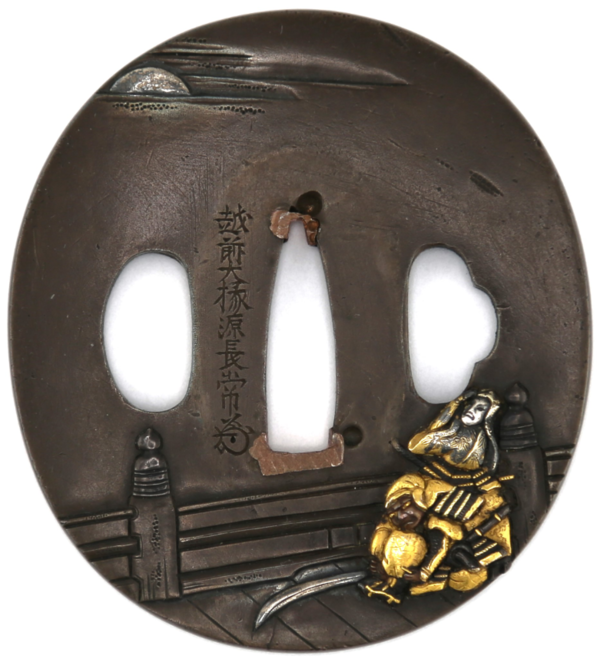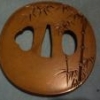Leaderboard
Popular Content
Showing content with the highest reputation on 04/04/2025 in all areas
-
I recently picked up this set, and went down a bit of a rabbit hole trying to get a full picture of the details depicted. I thought that I would share what I have found. There are other posts referencing this motif, but I didn’t find one that gave details… Happy to have any other details that I have missed, and shares from anyone else who has tosogu on the same theme. The set The tsuba is almost circular. It is shakudō, with a nanako ground, and chiseled in relief with details in gold. The tsuba shows the race across the Uji River. The fuchi-kashira show samurai at a Shinto shrine. The Race Across the Uji River (1180) This set has the depiction of a scene from the 14th-century military epic “The Tale of the Heike” (Heike monogatari). In the telling of this part of the story the Taira army were chasing a rebel army that had been raised by Prince Mochihito. The two armies met at the site of a bridge across the Uji river. The following confrontation became known as the First Battle of Uji (1180). The rebels stripped the bridge back to its bare bones (see the top left of the tsuba) forcing the armies to confront each other in an archery duel, which tended to favour the rebels as they had warrior monks on their side who used powerful bows that could penetrate the wooden shields used at the time. The battle wore on until sunset with the broken bridge as a chokepoint leading to stalemate. As the sun set, a retainer on the Taira side suggested that they should try to ford the river or go around to find another route. The river was swollen by heavy rains, but Sasaki Takatsuna and Kajiwara Kagesue decided to lead a contingent of 300 samurai across the river to engage with the enemy on land. The two of them rushed to get across the river first with Sasaki Takatsuna cheating a little by calling out to his rival that his mount’s saddle girth was loose, allowing him to ride ahead while Kajiwara Kagesue checked to see if his saddle was secure. On the tsuba we can see Sasaki Takatsuna and Kajiwara Kagesue, racing to get across the river. The position and depiction of Kajiwara Kagesue on the right is very closely mirrored by this diptych held by the Walters Art Museum. We can see Kajiwara Kagesue holding his bowstring in his mouth in the same way, and his horse is twisting to his left too. Holding the bowstring in his mouth seems to be a common trait in depictions of Kajiwara Kagesue as he crosses the river. The reverse of the tsuba has a group of three samurai on the opposite bank of the river, with the bridge in the upper right. They are presumably the opposing army, and seem to be gesturing to their enemies across the river. It’s hard to say exactly what action from the story is being depicted on the fuchi-kashira. The kashira shows a samurai at a shrine which could be related to the fact that Prince Mochihito had stayed at the Mii-dera temple before moving his forces to Uji. The fuchi shows samurai (possibly the main characters) preparing or resting next to a tied up horse. This battle seems to have been a popular moment of the story for depiction on tosogu and other art forms, with examples such as those above (and many others that have been shared on this board in the past), and this kozuka in the MFA Boston also showing the beginning of the race across the river. This screen held at the Met shows another view of the start of the race to cross the river, with the broken bridge in the background. Sources: https://www.metmuseum.org/art/collection/search/78537 https://art.thewalters.org/object/95.181/ https://en.wikipedia.org/wiki/Battle_of_Uji_(1180)2 points
-
Thomas I love Sue Bizen blades ( esp Kiyomitsu ) and I 100% I agree with your view. I love the time period and the practical nature of their blades and I always enjoyed finding the few good ones out of the many rough samples. My most prized possession is a Tokubetsu Hozon kiyomitsu I purchased last year for roughly the same price as the ones above. It s just so surprising for me to see ones like above being priced in the same range as Tokubetsu Hozon Late Kamakura/Nanbokucho works. I am both happy to see that people find the appeal in them but also bummed at how high the prices are lol. One thing I can understand is the appeal of Ubu signed koto works. For some reason mumei suriage/O-suriage blade has started to bother me a bit lately. I think it s the idea of something being greatly altered and never being 100% certain of it s maker/school. Thank you for your input on the thread 🙏 -Kevin L2 points
-
2 points
-
Honestly - and I'm sure I'm not making any friends - but I can count the really good Sue Bizen works I've seen in recent years on one hand. I know that Sukesada & Co can do it and then I think, holy sh..., what a great blade! But most of what you find, including the linked swords, are (in my eyes) weapons, nothing more. Robust swords with a sharp edge, conceptless hada with rough weld seams and conceptless hamon, a hardening that often looks rather uncontrolled. One should not try to see anything artistic in this. Of course you can find something like this interesting and collect it, that is completely legitimate. And if dealers are asking such prices, then there seems to be a corresponding clientele.2 points
-
2 points
-
Looks Chinese... and by "Chinese" I am not implying modern fake. I scanned through all three volumes of Jan Culbertson's Chinese Swords and could not find a match though. Hopefully you can get more pictures @Bruce Pennington Conway2 points
-
Hi Bruce, After going through my Fuller and Gregory books and also Dawsons cyclopedia, I did not find anything that matches in a satisfying way. I searched the diplomat sections and beyond. The emblem itself reminds me most of the emblems found on police badges. See the first two color photos below from Dawsons. Third and fourth black and white photo, is an unusual item listed in Fuller and Gregory military and civil swords and dirks. Still, nothing quite fits… All the best, -Sam Dawsons: Fuller and Gregory:2 points
-
I believe there are several effects that are called utsuri. The description given by Yoshindo Yoshihara I believe is describing the formation of banite in the microstructure. Banite forms at a different temperature range than martensite. It is almost as hard as martensite but is much tougher and resistant to cracking. It is very desirable from the viewpoint of structural integrity. I believe many older blades were made without the use of clay. I suspect a large bar of iron was heated to a suitable temperature and the edge of the blade to be heat treated was placed against it to allow heat by conduction. I don’t see any other simple way to achieve a controlled differential application of heat on a long slender sword without modern technology. I have experimented with this and have produced “utsuri” similar to what I see on older blades. Not every steel will produce utsuri. As Rivkin mentioned, different steels have different thermal conductivity characteristics. It is difficult to produce utsuri on most modern steels, especially with high carbon content or alloying elements. I find that tamahagane with a medium carbon content works better for producing utsuri. I did X-ray diffraction analysis on a mid kamakura tachi with vibrant utsuri and found the core steel was high carbon (.7%) while the exterior layers were mid range carbon content (.45 % to .55%). I haven’t done an exhaustive study of the effects called utsuri. I don’t have the samples, time, money, energy, etc. These are just my limited observations from several years ago, so take that into account.2 points
-
This is a 50 Monme Ozutsu from Sendai, Date Masamune's stronghold north of Edo. Sendai (仙台 today) used to be written with the old Kanji for 'dai'. i.e. 仙臺, as seen in the Mei under the barrel. Although rare, Sendai guns being quite sought after, and of relatively large caliber, this hand-cannon was to me always slightly disappointing, being very plain, and with no mon on the barrel. (Hidden underneath the barrel there are two faint stamps, one triple-comma mitsu-domoe, and one nine-star kuyomon.) On the other hand, there is some inlay, a splay of fuji wisteria-vine flowers and leaves down the serpentine, both on the viewing side, and equally on the back. I cannot recall having seen such style and placement of inlay before. In an effort to find out more about this gun, I came across the fact that Date Masamune had brought back a fuji root stock from the Bunroku campaign in Korea in the 1592-93, and today this wisteria plant is enormous, a huge presence in the city of Sendai. https://www.bing.com/search?q=伊達政宗ゆかりの藤&qs=n&form=QBRE&sp=-1&lq=0&pq=伊達政宗ゆかりの藤&sc=9-9&sk=&cvid=0FA35231BBE443FBB52CCB63F8AE2F42&ghsh=0&ghacc=0&ghpl= The cherries are coming into bloom, and this month so too will the wisteria be. In Europe wisteria can have a gentle aspect growing up the outside walls of country houses, but for the real meaning of 藤 Fuji, (think family names like 藤井Fujii, 藤原 Fujiwara, 後藤 Gotō, 加藤 Katō, etc.) you need to see how powerful these vines can grow in the wild. They are like a massive boa constrictor, crushing the life of any tree they choose to climb. Serpentine inlay photos should follow here... and yes, I did give them a polish; much foliage was completely hidden under layers of grime.1 point
-
It is stamped with a mei in kanji: Masayuki. See below.1 point
-
A very famous scene that appears throughout the Edo Period in Tosogu pieces Justyn! You see this motif a lot on fuchigashira and on the occasional tsuba as well. Here is an example from my collection that I acquired not too long ago signed "Hamano Noriyoshi". You should hopefully recognise similarities from your own such as the bow in the mouth of the riding samurai on your tsuba! The samurai should be Kajiwara Kagesue riding Minamoto no Yoritomo's horse. Here is a woodblock for comparison:1 point
-
1 point
-
I believe this is Seiryuken Eiju. https://www.google.com/search?client=ms-android-google&sca_esv=58560bd20a15475a&sxsrf=AHTn8zp5Hr0dcBVVU0Peg1qcnXs29I0QmA:1743779099394&q=seiryuken+site:www.militaria.co.za&nfpr=1&sa=X&ved=2ahUKEwi_z6Su076MAxVJp7AFHXjlI48QvgUoAXoECA0QAg&biw=411&bih=785&dpr=2.631 point
-
First, you’re absolutely right—prices for Sue Bizen blades, as well as high-quality late Mino works, are rising across the board at Japanese dealers. A big part of this is that older, historically desirable blades from the Kamakura and Nanbokucho periods are becoming increasingly scarce. As we’ve seen in recent auction sales, the prices for these top-tier swords are skyrocketing. Naturally, collectors and dealers are now turning their attention to what’s out there and looking for the next big "thing." Late Muromachi-period blades, long overlooked and often dismissed, are beginning to get the recognition they deserve. I’ve always found it curious that while scholars have traditionally celebrated Oei and early Muromachi Bizen blades, all of the Saijō-saku (highest-rated) Bizen smiths listed by Fujishiro actually come from the early Sengoku period: Hikobei and Yosozaemon Sukesada, as well as Ukyo no Suke and Jirozaemon Katsumitsu. In fact, every Saijō-saku smith from the Muromachi period—Muramasa, NoSada, Magoroku Kanemoto—belongs to this same era. (Full disclosure, I've long collected Katsumitsu family swords in addition to Soshu blades.) With high-end Sōshū and related works nearly gone from the market, and top-quality Ko-Bizen and Nanbokuchō Bizen works increasingly difficult to find, attention is now shifting to top quality Muromachi and Sue Bizen blades—especially those that are fully signed. NoSada and Magoroku Kanemoto are getting serious interest, too. Just 10 years ago, you could pick up a moroha tanto by Sukesada or Katsumitsu for $6,000–$10,000. Now? Try finding one for under $20,000. And if you’re looking for a Sue Bizen blade that is signed, dated, ubu, in good condition, not machi-okure, with a single mekugi-ana and a horimono—you’ll probably need a note from your bank manager to be able to buy it. Many myths have circulated about Sue Bizen blades over the years—most of them unfounded. If you still doubt their value as premier works of the era, I recommend reading the account of Katsumitsu-Munemitsu and the warlord Akamatsu Masanori. Personally, I’m glad these blades are finally being seen through fresh eyes. Fully-inscribed works with complete names and dates by these smiths have always been exceptional. I expect their prices will continue to climb—until, like the great swords before them, they’re locked away in private collections or viewable only in display cases at places like Touken World. Daito by Murmasa have long vanished from the scene after the market was cornered by rich Japanese collectors. Now, good luck finding long swords by Sukesada, Katsumitsu and NoSada. That's partly because they didn't make many because of the katateuchi craze, but they did make them, you just can't find them. Happy hunting!1 point
-
According to a contact i recently met. According to him, a collector has passed away that owned a huge collection. Anyone heard about this ?1 point
-
At a glance, appears to set by Yoshioka Buzen (signed) and affirmed by Sato Kanzan.1 point
-
Thank you for your information. I do appreciate it, I think im in between that two type of collectors. I’m busy with my life but I still try to learn and understand bit by bit everyday. But I still can’t resist that beauty of a deep sori from a Koto Tachi. Maybe its just me. I will try to look at more and more swords from now before I can buy one at the right price.1 point
-
There are two ways to go about this and it would appear you are already leaning. There are basically two types of collectors. First, there are those with a deep appreciation of the history of nihonto. Then there are those who just want something they find visually appealing and the specifics of the blade are secondary. Based on your comment above, it would seem you are the latter. Absolutely nothing wrong with this type of collector and it makes your decision somewhat easy I would think. The question is, can you afford it? If the answer is yes, then you have to ask yourself, am I ok with taking a considerable loss on this purchase in the future? If the answer is yes, then it seems you have found something to add to your collection, easy peasy. Sometimes we just want what we want, regardless of the advice of others. We've all been there at some point in our lives, myself included. Good Luck with your purchase1 point
-
https://www.jauce.com/auction/h1178916285 Seems like gunto can be quite popular even in Japan, given the final selling price of 665K yen for this Yoshichika. I thought the frayed tsukamaki might turn some buyers off, but I guess the colonel's tassel and double ashi saya made up for it.1 point
-
1 point
-
Technically its all rust. The darker rust is the more stable form Fe3O4 or Iron 2 Oxide whereas the red rust is Fe2O3 or Iron 3 Oxide which is the more volatile rust that we want to avoid. Darcy is a proponent of oiling the nakago to prevent further degradation (Yuhindo - Oil Your Nakago). On an o-suriage mumei blade like this, a light coat wouldn't be a bad idea. Just make sure to use separate tissues when applying oil to the nakago vs the blade so you don't get rust or dirt particles that scratch the polish on the blade.1 point
-
Basic thing to check is what are the cheapest items in the store. Price is a relative thing in collectibles, more so than in other fields. Otherwise - sue Bizen can be great. Kiyomitsu and early Sukesada in particular. I don't think it applies here. Jigane is rough. Middle one at least carries some fun.1 point
-
The descriptions are the owner’s name and the date of issue. The format was used until March 2012.1 point
-
To be clear, we're talking about a shinsakuto. It has horimono but no hi. Regrettably, the maker is no longer living, so I can't ask him. I like the combination of horimono and hi, which I sometimes see (like the 2 below). Also, like many contemporary swords, it's heavy, so hi would lighten it. Just askin' tho.1 point
-
A timely reminder to all those, like me, who like a blade exhibiting utsuri. Nefarious sellers out there praying on the appeal of this feature. https://www.facebook.com/photo/?fbid=2401552303244992&set=pcb.2401556073244615 https://www.facebook.com/photo/?fbid=2401552296578326&set=pcb.2401556073244615 A warning from Andrew Ickeringill " A warning to sword collectors... Please have a look at these pics taken from a Japanese auction site, when you look at this utsuri, what do you see? Have a good look and think about it before reading the below... This kind of utsuri was drawn to my attention a few years ago, a client had asked me to open a window on an old tachi. As soon as I saw the blade, I knew something was off... it had been acid etched (not unusual) but something else was going on with the utsuri. After a few minutes pondering I concluded that the utsuri was fake, but the owner wasn't convinced and still wanted a window opened. Sure enough, the window revealed the utsuri was completely artificial, it came right off and didn't return. I believe the sword pictured here has had the same treatment, it has no utsuri... well it might have some kind of utsuri underneath the artificial one, but I doubt it. I'm guessing it's been created using some kind of VERY strong chemical process, applied either very carefully with a cotton bud stick, or perhaps a stencil was used as a guide. I've been seeing this kind of "utsuri" quite a bit recently, mainly coming from the Japanese auction sites. It's a very cheeky deception that I imagine has fooled many people. So, how can I tell this is fake just from looking at pics? That's the hard part to explain, I'll do my best... For starters, how do you view utsuri? Similar to the way you view the hamon. Real utsuri generally can't be seen very well from the angle that you'd normally view the jigane from, which is from directly above. But the "utsuri" in these pics shows up very strong in the jigane pics. What about the shape/pattern of this "utsuri"? It seems there's a contrived shape and repetitive pattern. On a sword with this kind of gunome-ba, I'd expect real utsuri to mirror the hamon in a similar flow, the utsuri would rise where the hamon dips into valleys, and the utsuri would fall where the hamon peaks (this isn't always the case with real utusri, for example shirake-utsuri). But with this sword you can clearly see the pattern of the utsuri is often at odds with the flow of the hamon in a very unnatural way. Also, please note the granule-like/mottled texture of this "utsuri", it's a result of the acid and you don't see that effect in real utsuri. One more thing, look how defined this "utsuri" is, especially the area down towards the hamachi where they've tried to emulate a mizukage-like effect. It's so sharp and defined, like it's been painted on, well it basically has been! So, just beware of these Japanese auction sites and their swords, some are gimei, some are acid etched in the hamon and jigane, and some have completely artificial utsuri. I'm not saying don't buy from these sites, there are some good swords to be found there, but you need to be aware it's like navigating a minefield, please be cautious and don't get had! I wouldn't recommend buying anything from these sites unless it's at least papered Hozon level."1 point
-
Hi Bruno, I like the design! It's definitely been mounted, and looks to have some real age to it (the way the rust is peeling on the inside of the nakago ana heavily suggests this). If it is a real hand-forged piece though (I can't see any seams which is good), I still think someone may have messed around with it. There's clear evidence of rust and pitting all over, but it all looks the same colour as the surface: Similarly, the copper in the nakago ana is glossy? I've never seen this before. It feels like someone may have applied a layer or two of something. One to darken any rust spots (but not actually remove the flaking rust like they should have), and a second to make it look so shiny? (Black shoe polish perhaps?) I think combined, extra layers like this would reduce the level of detail we can see (especially in the mei), giving a similar impression to it being cast. At 30 euro's though I'd say you did really well! (FYI I am a tsuba novice - but I have worked on some removing heavy rust before)1 point
-
Away from my books until after work, but I'll comb through them when I get home in about 6 hours. Maybe someone will beat me to the punch before then Interesting emblem! Especially interesting it's repeated on the buckle. I share your fears of a fake, I don't like the way the fit of that fuchi looks... Can't say I recognize it, but I often forget more than I remember -Sam1 point
-
What does it look like when a sword is crying out for a hi (other than the absence of a hi)? Not meaning to criticize of course, it's your sword you can do whatever you want with it. But what makes you reconsider the choice of the smith not to cut a hi in the blade?1 point
-
Very true. First time I came across the term 'Utsuri' was in relation to a honyaki chef knife I purchased 7 years ago. The maker had referred to this feature in his description for the W2 tool steel blade as an indicator of the perfect heat treatment conditions.1 point
-
I would agree. There is nothing I can see to indicate that it was cast rather than hand forged. It is unusual, but that’s a good thing…1 point
-
It has been a very long time since i had an inkling to comment on the board but since i am in Japan and saw some amazing Nihonto i just dropped by and saw this very interesting topic. Utsuri is a result of the process of thermocycling the steel in different intervals befor yaki-ire. Koto smiths could not afford to make mistakes with their steel. Tamahagane was not in abundance (still isn't) and so thermocycling was used as a way to reduce any risk of issues when quenching. What we must do is look at the direct meaning of Utsuri (to change, to transition) those who own Koi will also understand Utsuri and its meaning. The swords were clay coated in cases and put through thermocycling many times before being quenched. New clay is applied at various intervals, removed and reapplied. This takes time and precission. This produces varying hardness at mm dissipation throught the koto blades. In the later Edo period swords were made in different styles and made in more flamboyance with an emphasis on hamon and the Shinogi was not really part of the same outer jacket of the sword overall so this process was cut back. This also made production of blades faster (no doubt the lessons of cutting corners in the Muromachi period). And so those smiths that reproduced Utsuri in the Edo period and now are following an extensive, time consuming process when making their blades.1 point
-
Why not replace the childish sarcasm with constructive explanation if you know the answer?1 point
-
There are a few more Tanuki in the Chōsen Gafu book - One looks like a Kashira design you will have to look out for? https://www.metmuseum.org/art/collection/search/24642 I also did a cleaned up copy of the book 154 pages of tosogu designs. https://www.amazon.com.au/Album-Designs-Metal-Carving-Chōsen/dp/1034179020 - Amazon and others want way too much, I can get soft cover copies for around $401 point
-
1 point
-
1 point
-
Yeah thats Peter Yorke, interestingly I got told he didnt have great pieces to then find out he had one of the largest and best collections in the UK! a good friend of mine was freinds with him and has seen some incredible pieces in his collection. Ive heard of some of the swords etc hes got and one thing I can say, is that is going to be one hell of a sale, id go as far as to say its probably going to be one of the best uk sales in a very very long time. Im looking forward to seeing what comes up. Will post the link on here for everyone to brose when it goes live at the auction house..1 point
-
Peter Yorke told me not to long ago he had 125 swords in his personal collection of which I was shown a few. however he was very private with his own stuff. What he did show as a special treat was what he said was the best two tanto I,ll ever see. Wonderfull blades and even better fittings, one Ishiguro masatsune and one Goto Ichijo.1 point
-
Going back over 40 years ago I knew Peter. I was just getting into swords. He always managed to find out about every single sword that cropped up, whether in auction or through dealers. I remember going into a few normal antique shops (when we actually had some really good ones) and seeing his trade card pinned on the wall behind the desk! He had a network that would notify him when anything was on the move anywhere. He was a prolific buyer and would buy just about everything irrespective of cost and very often totally unseen. However he would hardly ever sell anything good. He truly loved his swords although he didn’t always show it. We lost touch as I moved into Meiji era art although he phoned from time to time…..”just in case”. If indeed this is the collection in question I suggest we prepare to be gobsmacked. Respect Peter. RIP.1 point
-
He had one of the largest collections in the UK. Including some very good swords. The numbers quoted are accurate from what I’ve heard. Auction will be later in the year apparently.1 point
-
I have asked John. Im just curious about the number of swords that was mentioned Personally, not interested in buying swords at the moment and dont want to appear like some kind of vulture. Just curious about who this collector was and the numbers mentioned. Will get back.1 point
-
Someone should develop a cheap non-invasive metallurgical test to discern between cast iron and hand forged iron. Where have I read that before! Ha, ha, ha, ha, etc! Onward!0 points
-
Discussions about utsuri tend to follow the same pattern - there are few postulates and there are groups of people defending each. The basic problems are: a. There is no per se scientific analysis of utsuri which clearly demonstrates what it is. Unfortunately I am not aware of someone taking an old Bizen blade, looking at the structure and saying - within utsuri we have (a), outside we have (b). In blades without utsuri we have only (b). Repeat to confirm. Instead there are many people making conjectures about what (a) should be. Basically like wootz studies used to be around 1990-2000: there were couple of blades analyzed, but 95% of information in publications were conjectures which went like "since wootz got to be superior because otherwise why would they do it, it is probably nano-fulleren-carbon etc.". Reality is most old ironworking is about trying to adapt to very severe material/temperature/timeframe constraints. The lost knowledge of quantum-coherent-supersteel is associated with professors submitting a paper to nature. . b. Related to previous point - no clear experiment analyzing what is jifu utsuri, midare utsuri, Muromachi bo utsuri etc.. Is it the same (a)? Different? Is hardening or composition what determines jifu/midare/bo structure? c. Modern methods of making utsuri have one purpose - to make utsuri. Hopefully looking like the old one. The simplest way to do it is a fine done acid etch, but its cheating and yes, its mostly visible from the top. Still its popular in Japan. Real deal usually needs to be looked at from a side. But again - not always. So does it mean if I manage to make utsuri today I know how ko Bizen did jifu utsuri? Open question. Plus people who made really good utsuri in the past 200 years tended to be a bit silent about the details. So to summarize - in wootz only when people did the analysis of 30+ blades it became apparent what the "real wootz" is (except there are many still arguing that it is not). Studying utsuri basically means sacrificing (non-destructive testing is not used in professional iron metallurgy) a few old blades, targeting utsuri versus non-utsuri areas. I did such study with a single Muromachi Uda blade and basically it was very dirty steel with visible composition variation which even without hardening would produce some "utsuri" during polish. Is this universal? No, I don't think so. But I do suspect that considerable portion of utsuri variery is because of composition variation multiplied by hardening effect.0 points
-
0 points
-
Another point was... there was no artificial light to "observe" utsuri. Most token teachers had to wait for proper light (dawn? ) once a day. Still utsuri seems to have been à well mastered process in Bizen...0 points
-
First of all, I think that swordsmiths in the Early Koto period did not create utsuri intentionally. They primarily made weapons. The utsuri was just a side effect of the material's sensitivity to the yakiire process There are many great Kamakura blades from the Bizen school that do not have utsuri I'm not even sure if they were able to get the blade surface to a state where they could see the utsuri. Nice to see you back here @Rayhan0 points
This leaderboard is set to Johannesburg/GMT+02:00

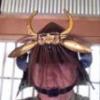


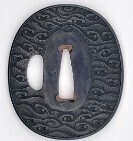









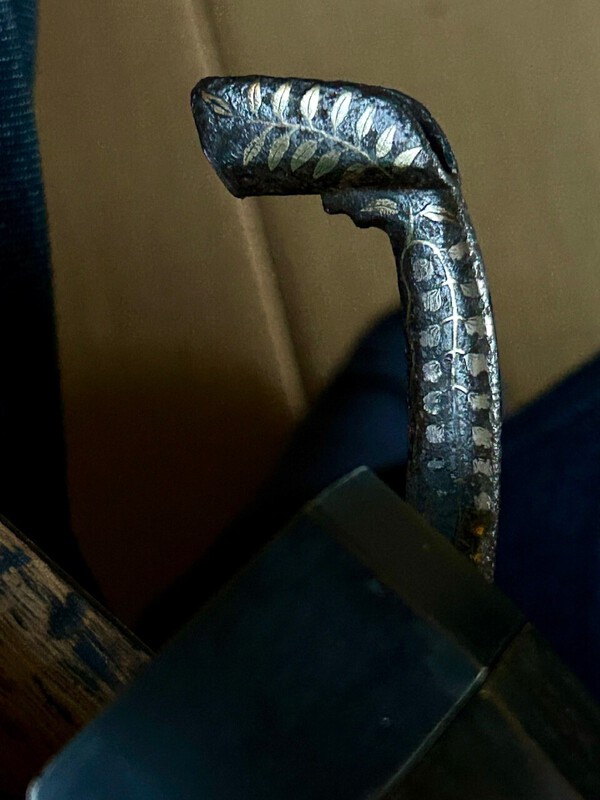


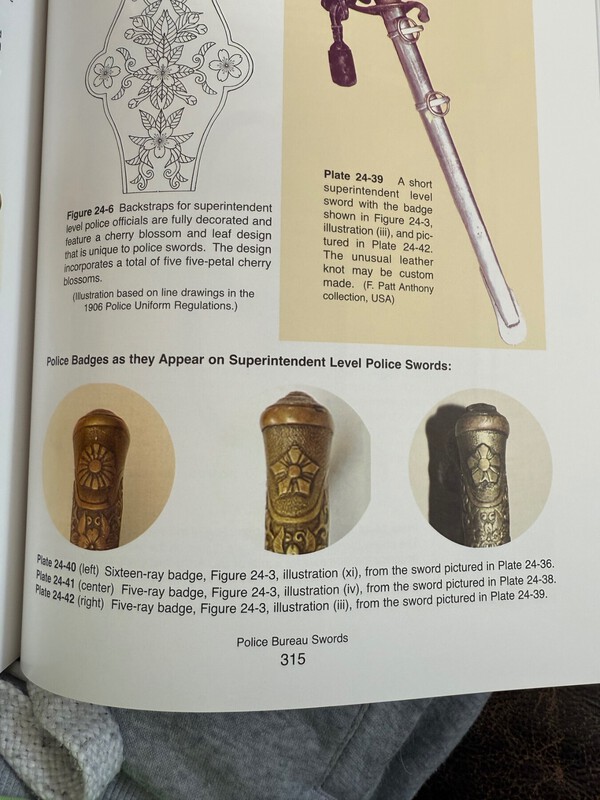



.thumb.png.4c5df79fec171b2dc4a23af38e280a4d.png)

